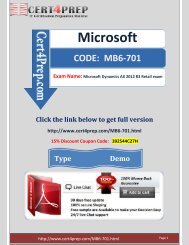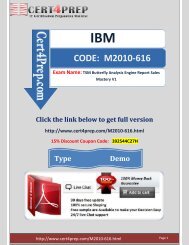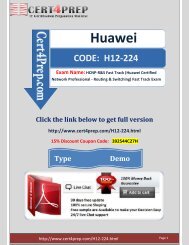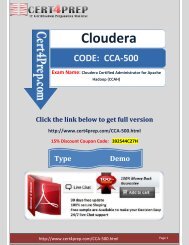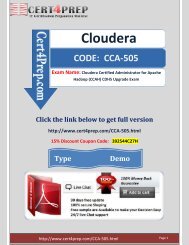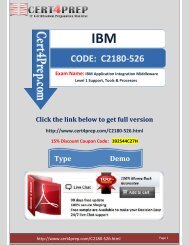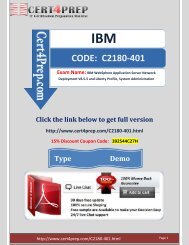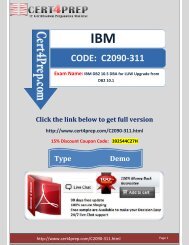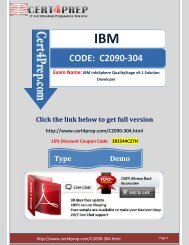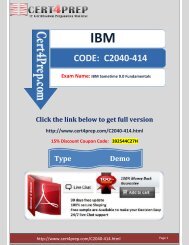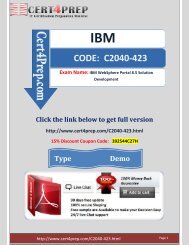SPHR Exam Practice Questions & Answers
You also want an ePaper? Increase the reach of your titles
YUMPU automatically turns print PDFs into web optimized ePapers that Google loves.
HRCI<br />
CODE: <strong>SPHR</strong><br />
<strong>Exam</strong> Name: <strong>SPHR</strong> - Senior Professional in Human<br />
Resources<br />
Click the link below to get full version<br />
http://www.cert4prep.com/<strong>SPHR</strong>.html<br />
15% Discount Coupon Code: 392544C27H<br />
Type<br />
Demo<br />
http://www.cert4prep.com/<strong>SPHR</strong>.html Page 1
Question: 1<br />
Which of the following functional areas covers activities related to planning for and managing entry into<br />
and exit from the organization to meet changing business needs?<br />
A. Workforce Planning and Employment<br />
B. Business Management and Strategy<br />
C. Human Resource Development<br />
D. Employee and Labor Relations<br />
Answer: A<br />
Explanation:<br />
Answer option A is correct.<br />
Workforce Planning and Employment covers activities related to planning for and managing entry into<br />
and exit from the organization to meet changing business needs. This includes practices for evaluating<br />
workforce requirements, recruitment and selection, developing an employer brand, managing records,<br />
establishing a succession plan, and exiting employees from the organization.<br />
Answer option B is incorrect. Business Management and Strategy looks at the "big picture" of the<br />
organization and requires an understanding of overall business operations, basic knowledge of other<br />
functional areas in the organization, and the ability to interact and work effectively with those functions.<br />
Answer option C is incorrect. Human Resource Development utilizes training, development, change, and<br />
performance management programs to ensure that individuals with the required knowledge, skills, and<br />
abilities are available when needed to accomplish organization goals.<br />
Answer option D is incorrect. Employee and Labor Relations address the practices for building positive<br />
employment relationships in both union and nonunion environments. This includes employee relations<br />
programs, workplace policies and procedures, dispute resolution programs, and collective bargaining<br />
activities.<br />
Chapter: Certifying Human Resource Professionals<br />
Objective: Development of the Human Resource Body of Knowledge<br />
Question: 2<br />
According to Knowles, there are five key assumptions about how adults learn. One of the assumptions is<br />
the learner's need to know. Which of the following statements is best associated with the assumption of<br />
the learner's need to know?<br />
A. I'm ready to learn this because what I learn will help me function better in some way.<br />
B. I understand why I need to learn this.<br />
C. What I learn today will help me solve problems at my workplace tomorrow.<br />
D. I've got lots of valuable experience that I want to draw upon to help me as I learn.<br />
http://www.cert4prep.com/<strong>SPHR</strong>.html Page 2
Answer: B<br />
Explanation:<br />
Answer option B is correct.<br />
The statement "I understand why I need to learn this" is an assumption that the learner understands the<br />
need to know the course material.<br />
Answer option A is incorrect. The statement "I'm ready to learn this because what I learn will help me<br />
function better in some way" is an example of the assumption of the learner's readiness to learn.<br />
Answer option C is incorrect. The statement "What I learn today will help me solve problems at my<br />
workplace tomorrow" is an example of the assumption of the learner's orientation to learning.<br />
Answer option D is incorrect. The statement "I've got lots of valuable experience that I want to draw<br />
upon to help me as I learn" is an example of the assumption of the learner's experience.<br />
Reference: Professional in Human Resources Certification Guide, Sybex, ISBN: 978-0-470-43096-5.<br />
Chapter 5: Human Resource Development. Official PHR and <strong>SPHR</strong> Certification Guide, HR Certification<br />
Institute, ISBN: 978-1-586-44149-4, Section III, The US Body of Knowledge.<br />
Chapter: Core Knowledge Requirements for HR Professionals<br />
Objective: Adult Learning Processes and Learning Styles<br />
Question: 3<br />
As an HR Professional you must be familiar with the project management processes and the<br />
stakeholders of projects. All projects can map to the project management lifecycle. Which one of the<br />
following best describes the project management lifecycle?<br />
A. It is a unique life of each project -from its initiation through its closing.<br />
B. It is the aggregation of the nine knowledge areas of project management: integration management,<br />
scope, schedule, costs, quality, human resources, communication, risk, and procurement.<br />
C. It is the life of the management of the project -from initiation, planning, execution, controlling,<br />
through closing.<br />
D. It is the life of a project to interact with all areas including scope, schedule, costs, quality, human<br />
resources, communication, risk, and procurement.<br />
Answer: C<br />
Explanation:<br />
Answer option C is correct.<br />
The project management lifecycle is the flow of project management activities through the five process<br />
groups of initiating, planning, executing, controlling, and closing.<br />
Answer option A is incorrect. This answer describes the project life cycle - which is unique to each<br />
project; not universal to all projects.<br />
Answer option B is incorrect. This answer describes the integrated nature of projects where<br />
performance in each knowledge area can affect the performance of all other knowledge areas.<br />
Answer option D is incorrect. This answer describes project integration management - the coordination<br />
http://www.cert4prep.com/<strong>SPHR</strong>.html Page 3
of all necessary project management processes throughout the nine knowledge areas of project<br />
management.<br />
Reference: PHR <strong>Exam</strong> Prep, Pearson Education, ISBN: 978-0-7897-3677-2. Chapter Three: Strategic<br />
Management. Official PHR and <strong>SPHR</strong> Certification Guide, HR Certification Institute, ISBN: 978-1-586-<br />
44149-4, Section III, The US HR Body of Knowledge.<br />
Chapter: Core Knowledge Requirements for HR Professionals<br />
Objective: Project Management Concepts<br />
Question: 4<br />
The Department of Labor establishes the rules for unemployment insurance and associated claims. Who<br />
administers the unemployment?<br />
A. The Department of Labor<br />
B. Each state<br />
C. Insurance companies<br />
D. Each organization<br />
Answer: B<br />
Explanation:<br />
Answer option B is correct.<br />
Unemployment insurance claims are managed locally within each state, but federal rules do apply.<br />
Answer option A is incorrect. Unemployment claims are not managed by the department of labor.<br />
Answer option C is incorrect. Insurance companies do provide unemployment insurance, but it's the<br />
local state government that manages the claims.<br />
Answer option D is incorrect. Each organization does not manage the unemployment claims.<br />
Reference: PHR <strong>Exam</strong> Prep, Pearson Education, ISBN: 978-0-7897-3677-2. Chapter Six: Total Rewards.<br />
Official PHR and <strong>SPHR</strong> Certification Guide, HR Certification Institute, ISBN: 978-1-586-44149-4, Section<br />
III, The US HR Body of Knowledge.<br />
Chapter: Core Knowledge Requirements for HR Professionals<br />
Objective: Diversity Concepts<br />
Question: 5<br />
A correlation coefficient is an example of a type of what?<br />
A. Qualitative analysis<br />
B. Quantitative analysis<br />
C. Job evaluation<br />
D. Learning matrix<br />
http://www.cert4prep.com/<strong>SPHR</strong>.html Page 4
Answer: B<br />
Explanation:<br />
Answer option B is correct.<br />
Qualitative analysis is a form of research that uses mathematical models such as correlation, correlation<br />
coefficient, and measures of central tendency to provide solutions to problems. Quantitative analysis<br />
attempts to measure historical data (B), a job evaluation measures the relative value of each job within the<br />
organization (C) and a learning matrix is a generic term that can be used to identify organizational learning<br />
strategies (D) . See Chapters 2 and 4 for more information.<br />
Chapter: Core Knowledge Requirements for HR Professionals<br />
Objective: Qualitative and Quantitative Analysis<br />
Question: 6<br />
This nonmathematical forecasting technique brings the participants together to share and discuss their<br />
ideas about the forecast. The ideas are then ranked based on the groups input. What technique is<br />
discussed?<br />
A. Management forecasts<br />
B. Delphi technique<br />
C. Nominal group technique<br />
D. Brainstorming<br />
Answer: C<br />
Explanation:<br />
Answer option C is correct.<br />
The nominal group technique is a nonmathematical forecasting technique in which participants meet in<br />
person and share ideas as in brainstorming sessions. The group discusses and ranks the forecasts<br />
collectively, not anonymously as in the Delphi technique.<br />
Answer option A is incorrect. Management forecasts are predictions made by experienced managers<br />
considered to be subject matter experts in their field or in the organization.<br />
Answer option B is incorrect. The Delphi technique uses rounds of anonymous surveys to predict a likely<br />
outcome. After each round of the survey, the results are tallied and a new survey can be resubmitted to<br />
the survey participants. Eventually, consensus is found among the group on forecasting, risks, and other<br />
organizational decisions.<br />
Answer option D is incorrect. Brainstorming allows the group to discuss and share ideas, but it doesn't<br />
rank the ideas or forecasts.<br />
Reference: Professional in Human Resources Certification Study Guide, Sybex, ISBN: 978-0-470-43096-5.<br />
Chapter Four: Workforce Planning. Official PHR and <strong>SPHR</strong> Certification Guide, HR Certification Institute,<br />
ISBN: 978-1-586-44149-4, Section III, The US Body of Knowledge.<br />
Chapter: Core Knowledge Requirements for HR Professionals<br />
Objective: Qualitative and Quantitative Analysis<br />
http://www.cert4prep.com/<strong>SPHR</strong>.html Page 5
Question: 7<br />
Your organization offers an employees' retirement benefit program that is covered by the Employee<br />
Retirement Income Security Act of 1974. The administrative responsibility for enforcement of the<br />
Employee Retirement Income Security Act of 1974 is divided among three government agencies. Which<br />
one of the following is not a government agency that helps to enforce ERISA?<br />
A. IRS<br />
B. Department of Labor<br />
C. Pension Benefit Guaranty Corporation<br />
D. FDIC<br />
Answer: D<br />
Explanation:<br />
Answer option D is correct.<br />
The FDIC is not one of the three agencies that help to enforce the requirements of ERISA.<br />
Answer options A, B, and C are incorrect. The IRS, Department of Labor, and Pension Benefit Guaranty<br />
Corporation are the three agencies that do help to enforce the requirements of ERISA.<br />
Reference: PHR <strong>Exam</strong> Prep, Pearson Education, ISBN: 978-0-7897-3677-2. Chapter Six: Total Rewards.<br />
Official PHR and <strong>SPHR</strong> Certification Guide, HR Certification Institute, ISBN: 978-1-586-44149-4, Section<br />
III, The US HR Body of Knowledge.<br />
Chapter: Core Knowledge Requirements for HR Professionals<br />
Objective: Employee Records Management<br />
Question: 8<br />
You are the HR Professional for your organization. You are discussing the status of your company's<br />
employees to determine who may be considered nonexempt versus exempt. Which one of the following<br />
types of employees can never be considered exempted from overtime provisions?<br />
A. Manual workers<br />
B. Sales people<br />
C. Managers<br />
D. Administrative assistants<br />
Answer: A<br />
Explanation:<br />
Answer option A is correct.<br />
Manual workers, i.e. people that complete repetitive work with their hands, physical skill, and energy,<br />
can never be exempted from overtime pay.<br />
http://www.cert4prep.com/<strong>SPHR</strong>.html Page 6
Answer options B, C, and D are incorrect. Sales people, managers, and administrative assistants can be<br />
exempted from overtime pay.<br />
Reference: PHR <strong>Exam</strong> Prep, Pearson Education, ISBN: 978-0-7897-3677-2. Chapter Six: Total Rewards.<br />
Official PHR and <strong>SPHR</strong> Certification Guide, HR Certification Institute, ISBN: 978-1-586-44149-4, Section<br />
III, The US HR Body of Knowledge.<br />
Chapter: Core Knowledge Requirements for HR Professionals<br />
Objective: Employee Records Management<br />
Question: 9<br />
Holly and Gary are HR Professionals in their organization and they are working to develop the strategic<br />
plan for their organization. Holly and Gary are using SWOT analysis to help understand the needs of<br />
human, financial, technological, capital, and other aspects of their organization. What is SWOT?<br />
A. SWOT is an analysis to define the strengths, weaknesses, openness, and timeliness of an organization.<br />
B. SWOT is an analysis to define the schedule, weaknesses, opportunities, and timetable of a project<br />
endeavor.<br />
C. SWOT is an analysis to define the seriousness, weaknesses, openness, and timetable of organization<br />
development.<br />
D. SWOT is an analysis to define the strengths, weaknesses, opportunities, and threats an organization<br />
may face.<br />
Answer: D<br />
Explanation:<br />
Answer option D is correct.<br />
SWOT is an analysis that can be used to determine the strengths, weaknesses, opportunities, and<br />
threats.<br />
SWOT analysis is a strategic planning method used to evaluate the Strengths, Weaknesses, Opportunities,<br />
and Threats involved in a project or in a business venture. It involves specifying the objective of the business<br />
venture or project and identifying the internal and external factors that are favorable and unfavorable to<br />
achieving that objective. A SWOT analysis may be incorporated into the strategic planning model.<br />
It is a part of business policy that helps an individual or a company to make decisions. It includes the<br />
strategies to build the strength of a company and use the opportunities to make the company<br />
successful. It also includes the strategies to overcome the weaknesses of and threats to the company.<br />
Answer option A is incorrect. This is not a valid definition of SWOT so this choice is incorrect. Answer<br />
option B is incorrect. This is not a valid definition of SWOT so this choice is incorrect.<br />
Answer option C is incorrect. This is not a valid definition of SWOT so this choice is incorrect.<br />
Chapter: Core Knowledge Requirements for HR Professionals<br />
Objective: Environmental Scanning Concepts<br />
Question: 10<br />
http://www.cert4prep.com/<strong>SPHR</strong>.html Page 7
There are many different types of organizations that people create to accomplish business goals. Which<br />
business organization has just one person who is responsible for all decisions in the business, retains all<br />
profits, and has unlimited personal liability for all business decisions?<br />
A. Partnerships<br />
B. Sole proprietorship<br />
C. Limited liability company<br />
D. Corporation<br />
Answer: B<br />
Explanation:<br />
Answer option B is correct.<br />
A sole proprietor is the owner of the business, has the authority over the business, and is responsible for<br />
all liabilities the business may incur. Sole proprietorships are the easiest organizations to create and<br />
generally to manage.<br />
Answer option A is incorrect. Partnerships are formed with two or more people and the people involved<br />
generally share the decisions, profits, and liabilities.<br />
Answer option C is incorrect. A limited liability company is similar to sole proprietorship, but the owner<br />
has limited liability and is somewhat protected from the faults and liabilities of the legal organization.<br />
Answer option D is incorrect. A corporation is a legal entity that limits liabilities to the assets of the<br />
organization.<br />
Reference: Professional in Human Resources Certification Study Guide, Sybex, ISBN: 978-0-470-43096-5.<br />
Chapter Four: Workforce Planning and Employment. Official PHR and <strong>SPHR</strong> Certification Guide, HR<br />
Certification Institute, ISBN: 978-1-586-44149-4, Section III, The US Body of Knowledge.<br />
Chapter: Business Management and Strategy<br />
Objective: Organizations<br />
Question: 11<br />
The human resource professional fulfills three core roles in any organization. These three roles help<br />
propel the company's success. Which of the following statements best describes the roles of an HR<br />
professional?<br />
A. Human resource professionals fulfill strategic, operational, and administrative roles.<br />
B. Human resource professionals fulfill legal, operational, and administrative roles.<br />
C. Human resource professionals fulfill strategic, operational, and logistical roles.<br />
D. Human resource professionals fulfill functional, operational, and logistical roles.<br />
Answer: A<br />
Explanation:<br />
Answer option A is correct. Human resource professionals help an organization achieve its goals through<br />
http://www.cert4prep.com/<strong>SPHR</strong>.html Page 8
strategic, operational, and administrative roles. The strategic role builds on employee strengths. The<br />
operations role manages the employee relations and recruiting functions. The administrative role<br />
describes compliance with regulations, employee records, and confidentiality of employee information.<br />
Answer option B is incorrect. Legal isn't a role of the HR professional; compliance with regulations is part<br />
of the administrative role.<br />
Answer option C is incorrect. Logistical is not one of the three roles of an HR professional.<br />
Answer option D is incorrect. Functional and logistical are not roles of an HR professional.<br />
Reference: Professional in Human Resources Certification Study Guide, Sybex, ISBN: 978-0-470-43096-5.<br />
Chapter Four: Workforce Planning and Employment. Official PHR and <strong>SPHR</strong> Certification Guide, HR<br />
Certification Institute, ISBN: 978-1-586-44149-4, Section III, The US Body of Knowledge.<br />
Chapter: Business Management and Strategy<br />
Objective: Organizations<br />
Question: 12<br />
Each collective bargaining agreement outlines the process to file a grievance. Most agreements define a<br />
four-step approach to the grievance procedure. During which one of the following steps of the grievance<br />
procedure, might<br />
he president of the local union meet with the manager of the plant at which the employee with the<br />
grievance works?<br />
A. Initiate the complaint<br />
B. Escalate the complaint internally<br />
C. Reach the highest level of internal escalation<br />
D. Participate in binding arbitration<br />
Answer: B<br />
Explanation:<br />
Answer option B is correct.<br />
The four stages of the grievance procedure are: Initiate the complaint, Escalate the complaint internally,<br />
Reach the highest level of internal escalation, and then Participate in binding arbitration. The second<br />
phase of the grievance procedure likely has the local union's president meet with the plant manager to<br />
try to find a resolution.<br />
Answer option A is incorrect. This is the first step of the grievance procedure, and the supervisor of the<br />
person who experienced the grievance is notified of the complaint and offered a time period to find a<br />
resolution.<br />
Answer option C is incorrect. This phase of the grievance procedure may actually bring the president of<br />
the national union to meet with president of the company, where the union member works.<br />
Answer option D is incorrect. If no resolution has been met, this final procedure causes the grievance to<br />
move onto the court systems.<br />
Reference: PHR <strong>Exam</strong> Prep, Pearson Education, ISBN: 978-0-7897-3677-2. Chapter Seven: Employee and<br />
Labor Relations. Official PHR and <strong>SPHR</strong> Certification Guide, HR Certification Institute, ISBN: 978-1-586-<br />
44149-4, Section III, The US HR Body of Knowledge.<br />
Chapter: Business Management and Strategy<br />
http://www.cert4prep.com/<strong>SPHR</strong>.html Page 9
Objective: Strategy<br />
Question: 13<br />
A business professional must plan on the direction and mission of the organization. <strong>Questions</strong> that<br />
direct the business ask where is the business now, where does the business want to go, how will the<br />
business get there, and how will we know when it has arrived. What term is assigned to this business<br />
introspection?<br />
A. Planning<br />
B. Mission building<br />
C. Strategic planning<br />
D. Vision<br />
Answer: C<br />
Explanation:<br />
Answer option C is correct.<br />
These questions are all indicative of strategic planning.<br />
Answer option A is incorrect. While this is a form of planning, this isn't the best answer for the question.<br />
Answer option B is incorrect. Mission building happens as the business is in its startup phase of the<br />
organizational life cycle.<br />
Answer option D is incorrect. Vision is linked to the mission of the company. It's the image and model<br />
the founder and executives see for the organization.<br />
Reference: Professional in Human Resources Certification Study Guide, Sybex, ISBN: 978-0-470-43096-5.<br />
Chapter Four: Workforce Planning and Employment. Official PHR and <strong>SPHR</strong> Certification Guide, HR<br />
Certification Institute, ISBN: 978-1-586-44149-4, Section III, The US Body of Knowledge.<br />
Chapter: Business Management and Strategy<br />
Objective: Strategy<br />
Question: 14<br />
What plan captures and projects how human resources will contribute to achieving the organization's<br />
strategic plan?<br />
A. Human capital management plan<br />
B. HR Staffing Plan<br />
C. Resource Development Plan<br />
D. Change management plan<br />
Answer: A<br />
http://www.cert4prep.com/<strong>SPHR</strong>.html Page 10
Explanation:<br />
Answer option A is correct.<br />
The human capital management plan is a plan created by HR to define how the HR department and staff<br />
will help the organization achieve its strategic goals.<br />
Answer option B is incorrect. The HR Staffing Plan is not a valid plan for this question.<br />
Answer option C is incorrect. The Resource Development Plan is an HR plan that describes the<br />
competency and skills improvement for the human capital in the organization.<br />
Answer option D is incorrect. A change management plan describes the change and how the company<br />
may best overcome the challenges and risks the change presents.<br />
Reference: Professional in Human Resources Certification Study Guide, Sybex, ISBN: 978-0-470-43096-5.<br />
Chapter Four: Workforce Planning and Employment. Official PHR and <strong>SPHR</strong> Certification Guide, HR<br />
Certification Institute, ISBN: 978-1-586-44149-4, Section III, The US Body of Knowledge.<br />
Chapter: Business Management and Strategy<br />
Objective: Strategy<br />
Question: 15<br />
An HR audit is designed to help management do what?<br />
A. Improve employee morale.<br />
B. Analyze HR policies, programs, and procedures against applicable legal requirements.<br />
C. Improve HR effectiveness.<br />
D. All of the above.<br />
Answer: D<br />
Explanation:<br />
Answer option D is correct.<br />
An HR audit is an organized process designed to identify key aspects of HR in the organization such as<br />
employee morale, HR policies, programs and procedures, and HR effectiveness. See Chapter 3 for more<br />
information.<br />
Chapter: Business Management and Strategy<br />
Objective: Strategic Management<br />
Question: 16<br />
What term is best described as examining the entire organization to simplify or eliminate unnecessary<br />
processes with the goal of increasing customer satisfaction through improvements in efficiency?<br />
A. Reengineering<br />
B. Corporate restructuring<br />
C. Workforce reduction<br />
D. Mergers and acquisitions<br />
http://www.cert4prep.com/<strong>SPHR</strong>.html Page 11
Answer: A<br />
Explanation:<br />
Answer option A is correct.<br />
Reengineering examines the efficiencies of the organization and how it affects profits, production,<br />
capacity, and customer satisfaction and then acts to improve the organization and customer satisfaction<br />
by removing unneeded processes.<br />
Answer option B is incorrect. Corporate restructuring looks to eliminate individual units to reduce or<br />
eliminate redundancy or bureaucratic processes.<br />
Answer option C is incorrect. Workforce reduction is also the reduction of resources, it is also known as<br />
downsizing, rightsizing, or reductions in force.<br />
Answer option D is incorrect. Mergers and acquisitions describe two or more units merging together<br />
into one.<br />
Reference: Professional in Human Resources Certification Study Guide, Sybex, ISBN: 978-0-470-43096-5.<br />
Chapter Four: Workforce Planning and Employment. Official PHR and <strong>SPHR</strong> Certification Guide, HR<br />
Certification Institute, ISBN: 978-1-586-44149-4, Section III, The US Body of Knowledge.<br />
Chapter: Business Management and Strategy<br />
Objective: Strategic Management<br />
Question: 17<br />
You need to participate in enterprise risk management and complete an HR-audit. Which of the<br />
following is the best definition of an HR-audit in regard to risk management?<br />
A. Identify the total number of employees in the organization<br />
B. Identify the competency of employees in each areas of the organization<br />
C. Identify the total number of employees by years of employment in the organization and verify their<br />
experience, education, and skills<br />
D. Identify the HR areas that may be out of compliance with legal requirements<br />
Answer: D<br />
Explanation:<br />
Answer option D is correct.<br />
An HR audit examines the areas of human resources management that may be out of compliance with<br />
legal requirements or that are in need of updating.<br />
Answer options A, B, and C are incorrect. These are not examples of an HR audit.<br />
Reference: Professional in Human Resources Certification Study Guide, Sybex, ISBN: 978-0-470-43096-5.<br />
Chapter Four: Workforce Planning and Employment. Official PHR and <strong>SPHR</strong> Certification Guide, HR<br />
Certification Institute, ISBN: 978-1-586-44149-4, Section III, The US Body of Knowledge.<br />
Chapter: Business Management and Strategy<br />
Objective: Strategic Management<br />
http://www.cert4prep.com/<strong>SPHR</strong>.html Page 12
Question: 18<br />
As an HR Professional, you must be familiar with many laws and the process of how laws come into<br />
existence. One type of law is an administrative law. Which of the following is NOT an example of an<br />
administrative law?<br />
A. Agency rules and regulations<br />
B. Executive orders<br />
C. Agency orders<br />
D. Corporate governance<br />
Answer: D<br />
Explanation:<br />
Answer option D is correct.<br />
Corporate governance refers to the influences that may impact the way corporations are managed, not<br />
the way a bill may become a law.<br />
Answer option A is incorrect. Agency rules and regulations are laws developed by federal agencies, such<br />
as OSHA.<br />
Answer option B is incorrect. Executive orders are orders signed by the president - they become laws<br />
after existing in the Federal Register for 30 days.<br />
Answer option C is incorrect. Agency orders are also laws originating from federal agencies such as the<br />
National Labor Relations Board.<br />
Reference: Professional in Human Resources Certification Study Guide, Sybex, ISBN: 978-0-470-43096-5.<br />
Chapter Four: Workforce Planning and Employment. Official PHR and <strong>SPHR</strong> Certification Guide, HR<br />
Certification Institute, ISBN: 978-1-586-44149-4, Section III, The US Body of Knowledge.<br />
Chapter: Business Management and Strategy<br />
Objective: Corporate Governance<br />
Question: 19<br />
John is the Senior HR Professional for his organization and he's reviewing his company's code of<br />
conduct. Which of the following statements best describes a code of conduct?<br />
A. A code of conduct is a statement of behaviors that the organization expects from its employees.<br />
B. A code of conduct is a statement of ideal standards that the organization is committed to uphold in its<br />
business practices.<br />
C. A code of conduct is a statement of ideal standards that the shareholders are expected to uphold in<br />
its business practices.<br />
D. A code of conduct is a statement of behaviors that the employees expect from its management.<br />
http://www.cert4prep.com/<strong>SPHR</strong>.html Page 13
Answer: A<br />
Explanation:<br />
Answer option A is correct.<br />
The code of conduct is an employer's expectation of employee behavior.<br />
Answer option B is incorrect. This statement describes the company's code of ethics.<br />
Answer option C is incorrect. This isn't a valid statement for the code of conduct.<br />
Answer option D is incorrect. All employees are expected to abide by the code of conduct, not just<br />
management or just employees.<br />
Reference: Professional in Human Resources Certification Study Guide, Sybex, ISBN: 978-0-470-43096-5.<br />
Chapter Four: Workforce Planning and Employment. Official PHR and <strong>SPHR</strong> Certification Guide, HR<br />
Certification Institute, ISBN: 978-1-586-44149-4, Section III, The US Body of Knowledge.<br />
Chapter: Business Management and Strategy<br />
Objective: Corporate Governance<br />
Question: 20<br />
As a Senior HR Professional, you may have to work with the board of directors on some organizational<br />
issues and goals. How does the board of directors come into existence?<br />
A. The founder of the organization chooses the members of the board.<br />
B. The members of the board are hired just like all employees.<br />
C. The shareholders of the company elect the board of directors.<br />
D. Regulations, laws, and policies determine who is eligible to serve on the board of directors.<br />
Answer: C<br />
Explanation:<br />
Answer option C is correct.<br />
Shareholders elect the board of directors.<br />
Answer option A is incorrect. The founder of the company doesn't choose the board - the shareholders<br />
of the company do.<br />
Answer option B is incorrect. Members of the board may be employees, but it's the shareholders that<br />
elect the board, not HR.<br />
Answer option D is incorrect. The shareholders of the company determine who will serve on the board,<br />
not regulations or laws. Reference: Professional in Human Resources Certification Study Guide, Sybex,<br />
ISBN: 978-0-470-43096-5. Chapter Four: Workforce Planning and Employment. Official PHR and <strong>SPHR</strong><br />
Certification Guide, HR Certification Institute, ISBN: 978-1-586-44149-4, Section III, The US Body of<br />
Knowledge.<br />
Chapter: Business Management and Strategy<br />
Objective: Corporate Governance<br />
http://www.cert4prep.com/<strong>SPHR</strong>.html Page 14
Question: 21<br />
As a Senior HR Professional, you should be familiar with the Balanced Scorecard. Which perspective of<br />
the Balanced Scorecard describes the criticality of customer focus and customer satisfaction?<br />
A. Learning and growth<br />
B. Business process<br />
C. Customer<br />
D. Financial<br />
Answer: C<br />
Explanation:<br />
Answer option C is correct.<br />
The customer perspective of the Balanced Score does focus on the criticality of customer satisfaction.<br />
Answer option A is incorrect. Learning and growth focus on employee training and attitudes towards the<br />
individual and corporate growth.<br />
Answer option B is incorrect. Business process scrutinizes internal key business activities.<br />
Answer option D is incorrect. Financial perspectives focus on the financial performance of the<br />
organization.<br />
Reference: Professional in Human Resources Certification Study Guide, Sybex, ISBN: 978-0-470-43096-5.<br />
Chapter Four: Workforce Planning and Employment. Official PHR and <strong>SPHR</strong> Certification Guide, HR<br />
Certification Institute, ISBN: 978-1-586-44149-4, Section III, The US Body of Knowledge.<br />
Chapter: Business Management and Strategy<br />
Objective: HR Metrics: Measuring Results<br />
Question: 22<br />
The Vietnam Era Veterans Readjustment Assistance Act (VEVRAA) requires which of the following?<br />
A. All contractors must list all job openings with state employment agencies.<br />
B. All employers must list all job openings with state employment agencies.<br />
C. State employment agencies must give preference to Vietnam veterans for senior-level management<br />
position referrals.<br />
D. State employment agencies must give preference to Vietnam veterans for positions lasting 3 days or<br />
longer.<br />
Answer: D<br />
Explanation:<br />
Answer option D is correct.<br />
VEVRAA applies to government contractors and requires that all job openings be listed with state<br />
http://www.cert4prep.com/<strong>SPHR</strong>.html Page 15
employment agencies except those that will be filled from within, are for senior-level management<br />
positions, or will last less than 3 days. See Chapter 4 for more information. Chapter: Workforce Planning<br />
and Employment<br />
Objective: Federal Employment Legislation<br />
Question: 23<br />
Mike is the HR Professional for his organization and he's documenting the relationship of contractors<br />
and employees in the organization. Mike is focusing on the control aspects as provided by the Internal<br />
Revenue Service. What aspect of the contractor control aspect is best described as how the business<br />
pays the worker?<br />
A. Financial control<br />
B. Behavioral control<br />
C. Type of relationship<br />
D. Contractual relationship<br />
Answer: A<br />
Explanation:<br />
Answer option A is correct.<br />
How the organization pays the worker is defined as a financial control for the individual. This affects the<br />
decision and determination that the person may be an employee and not a contractor.<br />
Answer option B is incorrect. Behavioral control defines who does the work, who controls the work, who<br />
directs the work, and how each action is done.<br />
Answer option C is incorrect. The type of relationship should be defined in the written contract,<br />
assuming one exists, between the person and the organization.<br />
Answer option D is incorrect. There is not a control aspect called "contractual relationship" as provided<br />
by the IRS so this choice is not valid.<br />
Reference: PHR <strong>Exam</strong> Prep, Pearson Education, ISBN: 978-0-7897-3677-2. Chapter Six: Total Rewards.<br />
Official PHR and <strong>SPHR</strong> Certification Guide, HR Certification Institute, ISBN: 978-1-586-44149-4, Section<br />
III, The US HR Body of Knowledge.<br />
Chapter: Workforce Planning and Employment<br />
Objective: Federal Employment Legislation<br />
Question: 24<br />
You are an HR Professional for your organization. Your organization employs 120 people in the United<br />
States. You are required to file the EEO-1 report for your organization by what date?<br />
A. January 1 of each year<br />
B. September 30 of each year<br />
C. April 15 of each year<br />
http://www.cert4prep.com/<strong>SPHR</strong>.html Page 16
D. The anniversary date of your organization reaching 100 employees<br />
Answer: B<br />
Explanation:<br />
Answer option B is correct.<br />
The EEO-1 Report, known as the Employer Information Report, must be submitted to the Department of<br />
Labor's Office by September 30 of each year for employers with 100 or more employees.<br />
Answer option A is incorrect. January 1 is not a valid answer. Answer option C is incorrect. April 15 is the<br />
tax filing deadline.<br />
Answer option D is incorrect. All organizations with 100 or more employees must file the EEO-1 report<br />
by September 30, not the anniversary date of your organization reaching 100 employees.<br />
Reference: PHR <strong>Exam</strong> Prep, Pearson Education, ISBN: 978-0-7897-3677-2. Chapter Four: Workforce<br />
Planning and Employment. Official PHR and <strong>SPHR</strong> Certification Guide, HR Certification Institute, ISBN:<br />
978-1-586-44149, Section III, The US HR Body of Knowledge.<br />
Chapter: Workforce Planning and Employment<br />
Objective: Federal Employment Legislation<br />
Question: 25<br />
Mark is an HR Professional for his organization and he has been given the assignment to create an<br />
Affirmative Action Plan for his company. Mark will also be considered to be designated the responsibility<br />
for this Affirmative Action Plan. What does the designation of responsibility mean?<br />
A. It means that Mark will be the person that reports on the plan's implementation to management<br />
B. It means that Mark will be the person responsible for actually implementing the plan<br />
C. It means that Mark will be the person that reports on the plan's implementation to the Department of<br />
Labor<br />
D. It means that Mark will be the manager for all Affirmative Action scenarios and issues within his<br />
company<br />
Answer: B<br />
Explanation:<br />
Answer option B is correct.<br />
The person who is designated the responsibility will be the individual responsible for implementing the<br />
plan in the organization.<br />
Answer option A is incorrect. Mark may report on the plan to management, but this isn't the complete<br />
and primary definition of the designation of responsibility.<br />
Answer option C is incorrect. Mark may be the person to report to the Department of Labor about the<br />
plan, but this isn't the complete definition.<br />
Answer option D is incorrect. Mark isn't necessarily the manager of affirmative action scenarios, but the<br />
implementation person for the plan.<br />
http://www.cert4prep.com/<strong>SPHR</strong>.html Page 17
Reference: PHR <strong>Exam</strong> Prep, Pearson Education, ISBN: 978-0-7897-3677-2. Chapter Four: Workforce<br />
Planning and Employment. Official PHR and <strong>SPHR</strong> Certification Guide, HR Certification Institute, ISBN:<br />
978-1-586-44149, Section III, The US HR Body of Knowledge.<br />
Chapter: Workforce Planning and Employment<br />
Objective: Federal Employment Legislation<br />
Question: 26<br />
What act prohibits discrimination on the basis of physical and mental disabilities?<br />
A. ADEA of 1967<br />
B. Rehabilitation Act of 1973<br />
C. VEVRAA of 1974<br />
D. IRCA of 1986<br />
Answer: B<br />
Explanation:<br />
Answer option B is correct.<br />
The Rehabilitation Act of 1973 prohibits discrimination on the basis of physical and mental disabilities.<br />
Answer option A is incorrect. The ADEA of 1967 is the Age Discrimination in Employment Act and<br />
addresses discrimination against employees and applicants greater than 40 years of age.<br />
Answer option C is incorrect. VEVRAA is the Vietnam Era Veteran's Readjustment Assistance Act.<br />
Answer option D is incorrect. IRCA is the Immigration Reform and Control Act, which prohibits<br />
discrimination on the basis of national origin and creates penalties for hiring illegal aliens.<br />
Reference: PHR <strong>Exam</strong> Prep, Pearson Education, ISBN: 978-0-7897-3677-2. Chapter Four: Workforce<br />
Planning and Employment. Official PHR and <strong>SPHR</strong> Certification Guide, HR Certification Institute, ISBN:<br />
978-1-586-44149, Section III, The US HR Body of Knowledge.<br />
Chapter: Workforce Planning and Employment<br />
Objective: Federal Employment Legislation<br />
Question: 27<br />
You are a HR Professional for your organization and your supervisor is asking you about the details of<br />
the Civil Rights Act of 1991, and what it means to your company. He wants to know what the total<br />
damages could be if an organization is found liable by a jury trial. What is the maximum amount that<br />
could be awarded to a victim of discrimination if the organization is found liable?<br />
A. $50,000<br />
B. $300,000<br />
C. $500,000<br />
D. There is no limited amount as the jury can determine damages<br />
http://www.cert4prep.com/<strong>SPHR</strong>.html Page 18
Answer: B<br />
Explanation:<br />
Answer option B is correct.<br />
The maximum amount that can be awarded is $300,000. This amount, however, can be lowered based<br />
on the number of people involved in the discrimination lawsuit.<br />
Answer options A, C, and D are incorrect. The maximum amount allowed by the Civil Rights Act of 1991,<br />
is $300,000.<br />
Reference: PHR <strong>Exam</strong> Prep, Pearson Education, ISBN: 978-0-7897-3677-2. Chapter Four: Workforce<br />
Planning and Employment. Official PHR and <strong>SPHR</strong> Certification Guide, HR Certification Institute, ISBN:<br />
978-1-586-44149, Section III, The US HR Body of Knowledge.<br />
Chapter: Workforce Planning and Employment<br />
Objective: Federal Employment Legislation<br />
Question: 28<br />
As a Senior HR Professional, you must be familiar with certain legal terms, laws, and regulations that<br />
affect how you and others operate in the workplace. One term is protected class. Which of the following<br />
statements best describes a protected class?<br />
A. A group of people who share a common characteristic and who are protected from discrimination<br />
and harassment on the basis of that shared characteristic.<br />
B. A group of people who share a common characteristic and who are exempt from discrimination<br />
regulations on the basis of that shared characteristic. C. A group of people who do not share a common<br />
characteristic and who are not protected from discrimination and harassment on the basis of that<br />
shared characteristic.<br />
D. A group of people who share a race and who are protected from discrimination and harassment on<br />
the basis of that race.<br />
Answer: A<br />
Explanation:<br />
Answer option A is correct.<br />
A protected class is a group of people who share a common characteristic, such as race or sex, and who<br />
are protected from discrimination and harassment on the basis of that shared characteristic.<br />
Answer option B is incorrect. A protected class is not exempt from discrimination, but protected from it.<br />
Answer option C is incorrect. This isn't a valid description of a protected class.<br />
Answer option D is incorrect. A protected class can be more than just race, so this statement, while<br />
partially correct, is not the best answer to the question.<br />
Reference: Professional in Human Resources Certification Study Guide, Sybex, ISBN: 978-0-470-43096-5.<br />
Chapter Four: Workforce Planning. Official PHR and <strong>SPHR</strong> Certification Guide, HR Certification Institute,<br />
ISBN: 978-1-586-44149-4, Section III, The US Body of Knowledge.<br />
http://www.cert4prep.com/<strong>SPHR</strong>.html Page 19
Chapter: Workforce Planning and Employment<br />
Objective: Federal Employment Legislation<br />
Question: 29<br />
A church has announced a position for a new minister. One of the requirements of the new minister,<br />
however, is that this person be a member of the faith of the church that is hiring. This is an example of<br />
which of the following in regard to Title VII?<br />
A. Piece-rate system<br />
B. Violation of the Title VII requirements not to discriminate employment based on religion<br />
C. Bona fide occupational qualification<br />
D. Violation of Title VII religious requirements for employment<br />
Answer: C<br />
Explanation:<br />
Answer option C is correct.<br />
This is an example of the bona fide occupational qualification for members of the clergy belonging to the<br />
same faith of the church that is hiring.<br />
Answer option A is incorrect. A piece-rate system describes how employees are paid based on their<br />
production volume.<br />
Answer options B and D are incorrect. This isn't a violation of the Title VII, but a bona fide occupational<br />
qualification.<br />
Reference: Professional in Human Resources Certification Study Guide, Sybex, ISBN: 978-0-470-43096-5.<br />
Chapter Four: Workforce Planning. Official PHR and <strong>SPHR</strong> Certification Guide, HR Certification Institute,<br />
ISBN: 978-1-586-44149-4, Section III, The US Body of Knowledge.<br />
Chapter: Workforce Planning and Employment<br />
Objective: Federal Employment Legislation<br />
Question: 30<br />
What type of analysis in an Affirmative Action Plan would create an organizational chart that includes<br />
information about incumbents' race, gender, and wages?<br />
A. Job Group Analysis<br />
B. Availability Analysis<br />
C. Utilization Analysis<br />
D. Workforce Analysis<br />
Answer: D<br />
http://www.cert4prep.com/<strong>SPHR</strong>.html Page 20
Explanation:<br />
Answer option D is correct.<br />
Workforce analysis, also known as organizational display, is an organizational chart that includes<br />
summary information about incumbents' race, gender, and wages. It is a basic and essential building<br />
block for human resources planning.<br />
Answer option A is incorrect. Job Group Analysis describes the analysis that nonconstruction contractors<br />
complete. The study begins the process of comparing the employer's representation of women and<br />
minorities to the estimated availability of qualified women and minorities available to be employed.<br />
Answer option B is incorrect. Availability analysis studies the availability of minorities and women for<br />
jobs and helps to establish goals to eliminate underutilization that may be found.<br />
Answer option C is incorrect. Utilization analysis studies the utilization of women and minorities and<br />
creates placement goals to eliminate the underutilization.<br />
Reference: Professional in Human Resources Certification Study Guide, Sybex, ISBN: 978-0-470-43096-5.<br />
Chapter Four: Workforce Planning. Official PHR and <strong>SPHR</strong> Certification Guide, HR Certification Institute,<br />
ISBN: 978-1-586-44149-4, Section III, The US Body of Knowledge.<br />
Chapter: Workforce Planning and Employment<br />
Objective: Federal Employment Legislation<br />
http://www.cert4prep.com/<strong>SPHR</strong>.html Page 21
HRCI<br />
CODE: <strong>SPHR</strong><br />
<strong>Exam</strong> Name: <strong>SPHR</strong> - Senior Professional in Human<br />
Resources<br />
Click the link below to get full version<br />
http://www.cert4prep.com/<strong>SPHR</strong>.html<br />
15% Discount Coupon Code: 392544C27H<br />
http://www.cert4prep.com/<strong>SPHR</strong>.html Page 22




